Despite years of heavy wartime operating tempo, the Air Force’s mobility fleet is well-postured for the coming decade—at least, part of it is.
Most of USAFs strategic airlifters are either relatively new or, if not, are receiving major upgrades and life-extending modifications. USAFs tactical airlift fleet is large, and the service is acquiring lots of new aircraft. In fact, USAF has more cargo-moving capacity than it needs and will shed some excess in order to meet new strategic guidelines.
Thats the situation regarding transports. Aerial tankers are something else altogether.
Even if the much-bedeviled KC-X program proceeds without further delaya big ifthe Air Force will be struggling with a scarcity of refuelers for many years to come. The problem will persist long after new tankers start arriving.
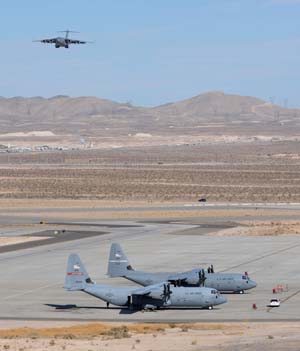 |
A C-17 prepares to land at Nellis AFB, Nev. Two “stretch” C-130s wait nearby. (USAF photo by A1C Stephanie Rubi)
|
The Right Mix
The airlift fleets ability to handle multiple contingencies at once was illustrated earlier this year, when Air Mobility Command was called upon to move a massive amount of relief aid to Haiti after a huge earthquake.
Although supporting surge deployments to Afghanistan as well as supporting forces in Iraq and commitments worldwide, AMC was able to accommodate relief operations with minimal impact on wartime operations. It did so by deferring some secondary-priority missions and temporarily withdrawing some aircraft from depot maintenance.
Within four days of the earthquake, AMC had run 100 sorties to Haiti, moved 1,200 persons, and delivered more than 600 short tons of relief supplies. Over several weeks, USAF evacuated more than 19,000 US citizens from the devastated island.
However, the watershed event for Air Mobility Commands planning this year was the release of Mobility Capabilities and Requirements Study 2016. Two years in the making, this study pitted overall US mobility optionsto include ships, rail, and other surface methods as well as airagainst a series of stressing scenarios.
The goal: Determine the right mix of capabilities for years to come.
Typically, 90 percent of US military freight travels by surface, and only 10 percent by air. The aerial percentages are somewhat higher in Afghanistan, where rugged terrain and a poor roads network compel greater reliance on airlift.
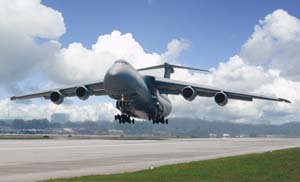 |
|
The study concluded that a plausible, worst-case contingency would only require 304 strategic airliftersthose very large aircraft of the C-5 and C-17 class able to carry outsize military gearbut the Air Force already has 334 such airplanes either in hand or on order.
Likewise, in the most stressing notional contingencies, no more than 335 tactical airlifters of C-130 size were needed, and the Air Force and its reserve components have 401 such aircraft either in hand or under contract.
The Air Force had previously set the operational minimum requirement at 316 strategic lifters, and Congress in turn cast this requirement as law. Now, the Air Force must get Congress permission to retire the aircraft the mobility study found to be excess to need.
However, the study also determined that the US needs 567 aerial tankers of the size of the venerable KC-135 or larger, but the nation has only 474 such aircraft in its inventory. In the MCRS scenarios, the tanker fleet came up short in the two most-stressing cases.
The Pentagon expects to receive contractor bids this month on the KC-X program. That program envisions the production of 179 KC-135 replacements, but the winning contractor probably wont be able to deliver more than about 15 new tankers per year, beginning in 2015, and the oldest KC-135s will be retired during the same period. The KC-X will not be a near-term fix.
In fact, the tanker problem is actually worse than the MCRS stated.
Up to 19 percent of the KC-135s are in depot at any one time, Brig. Gen. Michelle D. Johnson, US Transportation Command director of strategy, policy, programs, and logistics, told the House Armed Services air and land forces subcommittee in late April. Although the in-depot KC-135s might be tapped for a major contingency, they wouldnt be immediately available for action.
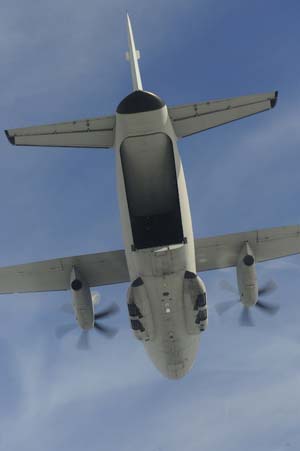 |
A C-27J readies for an air drop. ( Alenia North America photo by Katsuhiko Tokunaga) |
Boeing is planning to offer its NewGen 767-based tanker in the competition. The aircraft will be all-digital, having a flight deck derived from the 787 airliner, as well as a new refueling boom and other improvements. It will be an advancement over the KC-767 offered in previous rounds, Boeing officials said.
Northrop Grumman, which won the last round of the KC-X contest, elected not to bid this time, saying the evaluation rules were skewed toward a smaller airplane than the KC-45 the company was offering along with European Aeronautic Defense and Space Co. Northrop Grumman said it could not win. The company said it would not protest the evaluation rules and plunge the tanker contest into another round of acrimonious litigation.
However, once free of the partnership with Northrop Grumman, EADS announced in late April that it would re-enter the contest, this time as the prime contractor, and again offering the KC-45. EADS North America leaders said their airplane is well into flight test, is passing fuel through a new-design boom, has won five tanker competitions against Boeing, and that the reduced risk of their aircraft will overcome size issues. They insisted that their aircraft meets all USAF requirements.
Three Scenarios
The MCRS followed two controversial and flawed mobility studies. The first, in 2001, was quickly rendered moot in that it was released just before the war on terrorism began. It didnt consider the needs of special operations forces or tactical airlift, either. A 2005 study failed to consider scenario-driven requirements; it was a simple review of capabilities on hand. Neither review considered the effect on airlift of irregular warfare needs, a larger Army and Marine Corps, or the application of the strategic C-17 to intratheater, or tactical, lift operations.
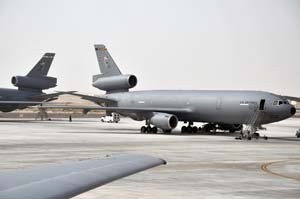 |
|
This time, the mobility review cast existing and anticipated mobility forces as they will exist in 2016 against three scenarios, each designed to stress the fleet in different ways.
In the first scenario, the US faced two major land wars in close succession, even as it responded to three domestic crises stemming from a natural disaster or terrorist attack. This was considered the toughest case, and demanded airlift capacity of 32.7 million ton-miles a day.
The second scenario saw the US conducting a major air and naval war overseas while answering a single domestic crisis. It required a maximum of 30.7 MTM/D.
The third scenario put the US in a major land war at the same time it was conducting a separate long-term irregular warfare campaign, while facing three domestic crises. Its requirement came in at 29.1 MTM/D.
All three scenarios assumed the US would still conduct air sovereignty missions at home while maintaining a worldwide naval presence.
The common denominator of all three scenarios was that the demand for strategic airlift peaked early in the conflict, during the deployment of forces phase. It also rose during redeployment to a second contingency but, again, tapered off shortly thereafter, entering a long-term sustainment phase.
The maximum need for 32.7 MTM/D was moderately below the existing capacity of 35.9 MTM/D.
In the scenarios, after initial deployments, intratheater lift rose in importance. The C-17s, which can operate from short and austere strips, could augment the smaller turboprop types such as C-130s in the intratheater role. It has actually done so many times in both Iraq and Afghanistan.
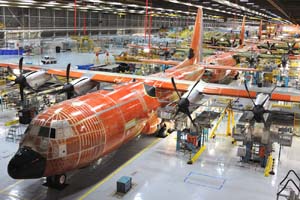 |
|
The study also found that delivery timelines would not speed up with the acquisition of more aircraft. The chief limiting factor in airlift is the ability of foreign airports to handle the offloaded materiel, according to the MCRS authors. A larger airlift fleet will not overcome this limitation, they said.
Air Force officials, in budget testimony this spring, asked Congress not to add further buys of C-17 aircraft, since USAF is already oversubscribed with strategic lift capability. Air Force Secretary Michael B. Donley told reporters in February that such addsCongress has increased the C-17 buy from 180 to 223 aircraft in the last few yearsrepresent a double hit on the service. First, he explained, the additions compel USAF to take procurement money away from higher-priority items, and second, Congress neglects to add operation and maintenance funds to run the additional aircraft.
Historic Highs
To get the fleet down to the MCRS levels, the Air Force wants to retire 17 C-5As in 2011, and another five in 2012. The service has long said that if Congress insisted on buying additional C-17s beyond the Air Forces requirement of 205 airplanes, it would have to retire older C-5As to keep the airlift fleet in balance.
Too much aluminum is almost as bad as not enough, Chief of Staff Gen. Norton A. Schwartz told the Senate Armed Services Committee in budget testimony in March.
Schwartz, a former head of US TRANSCOM, has long held that an excessively large airlift fleet would take contract work away from participants in the Civil Reserve Air Fleet. CRAF comprises air freight companies that make their airplanes available to the US in time of war. When CRAF is not activated but US forces are heavily engaged overseas, as they are now, CRAF participants get preference for air freight contracts. CRAF participants carry the bulk of airlifted cargo and passengers; the organic airlift fleet is used mainly to transport outsize or oversize military gear, or to fly into locations not safe enough for the commercial operators.
In the MCRS scenarios, CRAF was determined to offer plenty of additional capacity such that greater organic capacity was not needed.
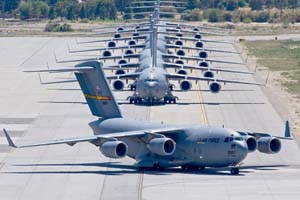 |
|
A TRANSCOM spokeswoman said that participation in CRAF today is near historic highs, with 1,149 aircraft committed overall by 32 US-flagged carriers. Participation, she said, has been driven up by depressed demand for airline services since 2001, as well as DOD commercial business exceeding $2 billion annually. Most, though not all of that business, supports operations in Iraq and Afghanistan.
Although CRAF was conceived as a purely wartime surge program, it has been functioning at a rate approaching all-up activation. In 2009, CRAF carriers made 5,453 trips for TRANSCOMnearly the same level as the 5,600 trips CRAF made during the whole of the 1991 Gulf War. CRAF also made 50 trips in support of Haiti relief this year.
By late April, the Air Force had accepted 197 C-17s, of the 223 on order. The service is on track to receive its 205th C-17 by the end of 2010, with 10 more coming in 2011 and eight to round out the 223 by February of 2012, according to Brig. Gen. Richard C. Johnston, USAF director of strategic planning. He told the House Armed Services subcommittee on air and land forces in April that if Congress will permit C-5s to be retired, USAF will go down to 94 [C-5s] in [Fiscal 2011] and probably 89 in Fiscal 2012. The combined actions would get AMC below 316 strategic airlifters in 2012, by which point it would need relief from Congress mandating that number of aircraft.
Establishing a “Floor”
The C-5 Galaxy is undergoing a major modification program, converting the flying behemoths from analog airplanes with old engines to digital aircraft with new engines. Only the newer batchthe C-5B/C fleet, which dates to the 1980sis scheduled to get the full modification, which is expected to extend the Galaxys service life another 20 years. However, one C-5A, dating to the 1960s, was also converted as a test aircraft, and neither pilots nor maintenance personnel involved in operational testing reported any difference in performance between it and the converted B models.
The re-engined C-5s have set time-to-climb and endurance with payload records, and it seems likely they will at least match or exceed the targeted 75 percent takeoff reliability called for in the upgrade. With greater availability, the improved C-5s will have the effect of adding capacity to AMCs fleet.
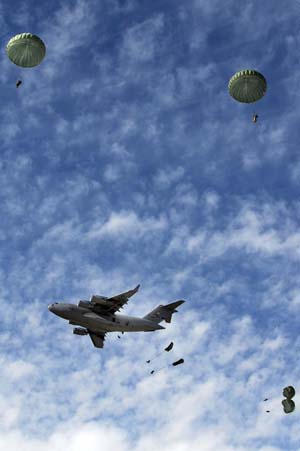 |
Above: Parachuters drop from a C-17 during a mobility air forces exercise over the Nevada desert. (USAF photo) |
The C-17 has also vastly increased AMCs capability. Since its introduction in the 1990s, the C-17 has been fitted with additional fuel tanks for extra range, and offers a large volume increase over the aircraft it replaced, the C-141 Starlifter.
Although a stretched version of the C-17 has been proposed (much as the C-141A was stretched with a fuselage plug adding 20 feet of length and considerable internal volume), the Air Force is not interested in such an aircraft, service officials reported.
The tactical airlift inventory is a more complicated issue. There are three types of aircraft to consider in the tactical fleet: the C-130 Hercules, which exists in three versions; the C-27 Spartan, a smaller aircraft just now in test; and a not-yet-chosen small airlifter the Air Force will use in conjunction with nascent partner air forces such as those in Afghanistan and Iraq.
The Air Force is building new C-130Js, having digital controls and more powerful engines, to replace its older C-130Es and C-130Hs, most of which are more than 30 years old and have been worked hard in nonstop action since the 1991 Gulf War. The services acquisition plan for the C-130 is highly uneven, however, amounting to small handfuls through the next five years.
USAF officials told Congress in late April that they intend to establish a floor of 375 C-130s: 335 as called for in the most stressing MCRS scenario, and a further 40 to be available to the Army for short-notice direct-support missions. In testimony before the House Armed Services air and land forces subcommittee, USAF leaders said they wish to retire 34 C-130s in Fiscal 2011: 28 from Little Rock AFB, Ark.the C-130 schoolhouseand potentially six from the Puerto Rico Air National Guard.
Because the Air Force fields most of the new-build C-130Js in the active duty inventory, the retirement of the older Hercules will require the service to borrow a number of older C-130s from the Air National Guard and Reserve to maintain representative aircraft at Little Rock Air Force Base, according to ANG chief Lt. Gen. Harry M. Wyatt III.
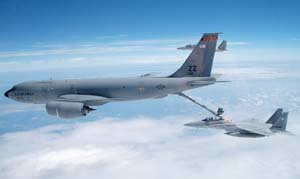 |
|
The C-130Es and Hs to be retired at Little Rock are primarily active duty airframes, Wyatt told the House Armed Services subcommittee on readiness in late April, and they are among the oldest flying. The active duty force trains C-130 pilots, and needed somewhat younger Es and Hs to continue the training, which it also does for allied nations that fly these types.
The loan of those tails will be temporaryending in 2015 at the latestand will diminish as retirements reduce the need for training aircraft of the older types, Wyatt said, noting that once the active duty force no longer needs them, the Air National Guard will get them back.
In Fiscal 2012, USAF wants to retire nine more C-130s, followed by eight in 2013, and another eight in 2014.
The C-27J was initially an Army program to replace its C-23 Sherpas, which had reached the end of their useful service lives, and some CH-47 helicopters, for the direct-delivery mission, supporting troops at the front lines. The Army had long insisted it needed its own cargo aircraft capability because it felt it couldnt rely on the Air Force in a pinch.
Meeting the Requirement
The Army requirementapproved by the Joint Requirements Oversight Councilwas for 78 airplanes. Then the Air Force became a partner in the program, and last year, Defense Secretary Robert M. Gates decided the Air Force would be the sole operator of the C-27.
The Air Force now plans to buy 38 C-27Js. To prove its commitment to meet the Armys needs, the Air Force last fall conducted an in-theater test in which C-130s standing in for the not-yet-acquired C-27s were on standby to meet any urgent Army needs.
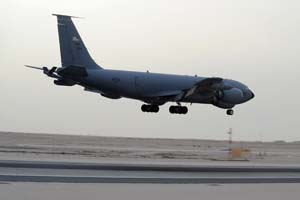 |
|
Lt. Gen. Philip M. Breedlove, USAF deputy chief of staff for operations, plans, and requirements, told the House Armed Services subcommittee on air and land forces in late April that the Army has been very, very happy with the results of the test, which is ongoing today, as USAF maintains 40 C-130s at the beck and call of Army forces in Afghanistan.
The Air Force plans to meet the requirement for 78 direct-delivery aircraft by buying 38 C-27Js and supplementing them with 40 C-130s earmarked to support Army direct-delivery needs, Breedlove said. The plan has been personally approved by theater commanders Gen. Stanley A. McChrystal and Gen. Raymond T. Odierno, he added.
Under questioning from Rep. Roscoe G. Bartlett (R-Md.), Breedlove admitted that no studies indicate the requirement for the C-27J is any number other than 78, but the Air Force feels the requirement can be more economically met from within its existing C-130 pool instead of buying new airframes.
The Air Force is also planning to buy 15 light mobility aircraft in Fiscal 2011. The need for these aircraft was identified in the Quadrennial Defense Review, and is part of USAFs effort to better shape itself to conduct irregular warfare operations. The airplane hasnt been picked yet, but it will be smaller than the C-27J, and will be able to operate from the most austere landing strips. A contract award is expected in May of 2011, with initial operational capability in late Fiscal 2012.